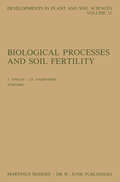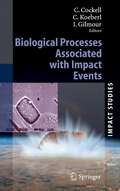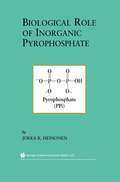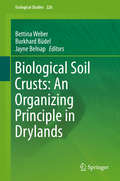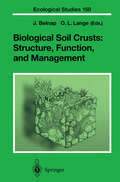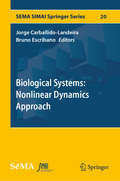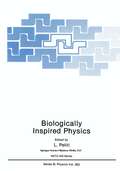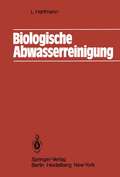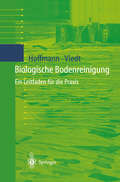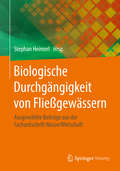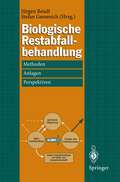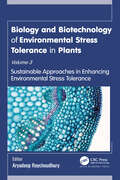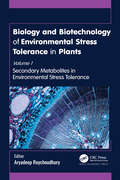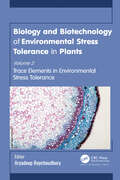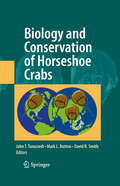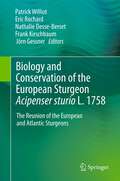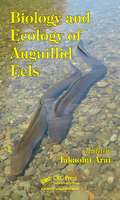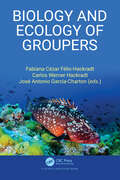- Table View
- List View
Biological Processes and Soil Fertility (Developments in Plant and Soil Sciences #11)
by J. Tinsley J. F. DarbyshireThe success of shifting cultivation systems developed by subsistence farmers testifies to the resilience of the "natural" soil-plant ecosystems to recover from the offtake of nutrients in crops and loss of soil struc ture. By contrast, the development of intensive cropping systems requires large inputs especially of nitrogen, together with phosphorus, sulphur and other essential elements in order to maintain the nutrient levels needed for abundant crop yields. As Dr. Cooke ably pointed out in his introductory lecture, the dis coveries and experiments of the 19th century encouraged farmers in temperate zones to rely greatly on chemical fertilizers supplements. However, the work of Charles Da{win on soil mixing by earthworms and the discovery by Hellriegel and Wilfarth in 1886 that the nodules on legume roots contain colonies of symbiotic bacteria able to "capture" atmospheric nitrogen molecules to the benefit of the host plant heralded a growing realization of the importance of soil biota in fertility studies. Biological fixation of nitrogen has been the theme of many meetings and publi~ations hitherto but at this Conference, convened on the delightful campus of Reading University, attention was mainly focussed on other biological processes in soil fertility. These Proceedings record the dominant themes and include six keynote addresses delivered at plenary sessions and seven introductory lectures to paper reading sessions by invited individuals plus 22 of the proferred papers, in six sections as tabled in the contents list.
Biological Processes Associated with Impact Events (Impact Studies)
by Charles Cockell Christian Koeberl Iain GilmourThe biological effects of asteroid and comet impacts have been widely viewed as primarily destructive. The role of an impactor in the K/T boundary extinctions has had a particularly important influence on thinking concerning the role of impacts in ecological and biological changes. th During the 10 and final workshop of the ESF IMPACT program during March 2003, we sought to investigate the wider aspects of the involvement of impact events in biological processes, including the beneficial role of these events from the prebiotic through to the ecosystem level. The ESF IMPACT programme (1998-2003) was an interdisciplinary effort that is aimed at understanding impact processes and their effects on the Earth environment, including environmental, geological and biological changes. The IMPACT programme has 15 member states and the activities of the programme range from workshops to short courses on topics such as impact stratigraphy, shock metamorphism, etc. The program has also awarded mobility grants and been involved in the development of teaching aids and numerous publications, including this one.
Biological Resources and Migration
by Dietrich WernerMigration of humans and animals, plants and even microbes is a ubiquitous global phenomenon. This book covers all forms of migration - plant, microbial, animal or human - and their mutual impact in detail. The contributions in this book are the result of an innovative International Conference and OECD Workshop aimed at triggering off the interdisciplinary dialogue between natural scientists and socioeconomists.
Biological Role of Inorganic Pyrophosphate
by Jukka K. HeinonenDr. Heinonen reviews and critically evaluates the scientific literature on the biological role of inorganic pyrophosphate (PPi ) published from 1940 to the end of 1999. He describes and classifies all known biochemical reactions that produce Ppi; describes and evaluates all published methods used in biological Ppi; and compiles and critically evaluates information on the concentration of PPi (with the conclusion that, contrary to common belief, PPi exists throughout the living world in rather high concentrations). Many reactions in which PPi is used as a biochemical energy source instead of ATP have been described in recent decades, especially in bacteria, protists, and plants. These reactions are evaluated from the bioenergetic and regulatory points of view. Also considered is the possible role of PPi as a source of biochemical energy in the primitive phases of life, before ATP. Data is presented on the regulatory role of PPi in living systems, such as activities of enzymes, fidelity of syntheses of macromolecules, and proliferation of cells. PPi may also regulate the formation and dissolution of bone as well as pathologic calcification of soft tissues and the formation of urinary stones. The formation of calcium pyrophosphate dihydrate crystals in the extracellular fluids of joints cause the disease called pseudogout. Biological Role of Inorganic Pyrophosphate book is a unique and invaluable source of references (about 1120) and summarized data for professionals who study or plan to study the role of PPi in living systems. Many different branches of science (biochemistry, microbiology, bioenergetics, plant physiology, parasitology, evolution, orthopedics, rheumatology) have involvement with PPi. This book sums up available knowledge in one place and will help scientists cross disciplinary boundaries.
Biological Soil Crusts: An Organizing Principle in Drylands (Ecological Studies #226)
by Bettina Weber Burkhard Büdel Jayne BelnapThis volume summarizes our current understanding of biological soil crusts (biocrusts), which are omnipresent in dryland regions. Since they cover the soil surface, they influence, or even control, all surface exchange processes. Being one of the oldest terrestrial communities, biocrusts comprise a high diversity of cyanobacteria, algae, lichens and bryophytes together with uncounted bacteria, and fungi. The authors show that biocrusts are an integral part of dryland ecosystems, stabilizing soils, influencing plant germination and growth, and playing a key role in carbon, nitrogen and water cycling. Initial attempts have been made to use biocrusts as models in ecological theory. On the other hand, biocrusts are endangered by local disruptions and global change, highlighting the need for enhanced recovery methods. This book offers a comprehensive overview of the fascinating field of biocrust research, making it indispensable not only for scientists in this area, but also for land managers, policy makers, and anyone interested in the environment.
Biological Soil Crusts: Structure, Function, and Management (Ecological Studies #150)
by Jayne Belnap Otto L. LangeBiological Systems: Nonlinear Dynamics Approach (SEMA SIMAI Springer Series #20)
by Jorge Carballido-Landeira Bruno EscribanoThis book collects recent advances in the field of nonlinear dynamics in biological systems. Focusing on medical applications as well as more fundamental questions in biochemistry, it presents recent findings in areas such as control in chemically driven reaction-diffusion systems, electrical wave propagation through heart tissue, neural network growth, chiral symmetry breaking in polymers and mechanochemical pattern formation in the cytoplasm, particularly in the context of cardiac cells. It is a compilation of works, including contributions from international scientists who attended the “2nd BCAM Workshop on Nonlinear Dynamics in Biological Systems,” held at the Basque Center for Applied Mathematics, Bilbao in September 2016. Embracing diverse disciplines and using multidisciplinary approaches – including theoretical concepts, simulations and experiments – these contributions highlight the nonlinear nature of biological systems in order to be able to reproduce their complex behavior. Edited by the conference organizers and featuring results that represent recent findings and not necessarily those presented at the conference, the book appeals to applied mathematicians, biophysicists and computational biologists.
Biological Weathering (large print)
by RnibThis page shows two images of a rock and a plant. There is a locator dot shown, which will be at the top left when the image is the correct way up. The image surrounded by a dashed line image border. The rock on the left has a small crack in its top. Some moisture has collected there and a tree seed has germinated into a small plant with three leaves. Its roots are starting to invade the rock. On the right of the page the rock has been split in two by the tree which is starting to get quite big. Its roots over time have forced the rock apart. The roots have reached the soil beneath the rock and are spreading through the soil. The soil is shown in cross section so the roots can be found.
Biological Weathering (UEB contracted)
by RnibThis page shows two images of a rock and a plant. There is a locator dot shown, which will be at the top left when the image is the correct way up. The image surrounded by a dashed line image border. The rock on the left has a small crack in its top. Some moisture has collected there and a tree seed has germinated into a small plant with three leaves. Its roots are starting to invade the rock. On the right of the page the rock has been split in two by the tree which is starting to get quite big. Its roots over time have forced the rock apart. The roots have reached the soil beneath the rock and are spreading through the soil. The soil is shown in cross section so the roots can be found.
Biological Weathering (UEB uncontracted)
by RnibThis page shows two images of a rock and a plant. There is a locator dot shown, which will be at the top left when the image is the correct way up. The image surrounded by a dashed line image border. The rock on the left has a small crack in its top. Some moisture has collected there and a tree seed has germinated into a small plant with three leaves. Its roots are starting to invade the rock. On the right of the page the rock has been split in two by the tree which is starting to get quite big. Its roots over time have forced the rock apart. The roots have reached the soil beneath the rock and are spreading through the soil. The soil is shown in cross section so the roots can be found.
Biologically Inspired Physics (Nato Science Series B: #263)
by L. PelitiThe workshop "Biologically Inspired Physics" was organized, with the support of the NATO Scientific Affairs Division and the Directorate-General for Science, Research and Development of the Commission of the European Communities, in order to review some subjects of physics of condensed matter which are inspired by biological problems or deal with biological systems, but which address physical questions. The main topics discussed in the meeting were: 1. Macromolecules: In particular, proteins and nucleic acids. Special emphasis was placed on modelling protein folding, where analogies with disordered systems in con densed matter (glasses, spin glasses) were suggested. It is not clear at this point whether such analogies will help in solving the folding problem. Interesting problems in nucleic acids (in particular DNA) deal with the dynamics of semiflexible chains with torsion and the relationship between topology and local structure. They arise from such biological problems as DNA packing or supercoiling. 2. Membranes: This field has witnessed recent progress in the understanding of the statistical mechanics of fluctuating flexible sheets, such as lipid bilayers. It appears that one is close to understanding shape fluctuations in red blood cells on a molec ular basis. Open problems arise from phenomena such as budding or membrane fusion. Experiments on model systems, such as vesicle systems or artificial lipids, have great potential. Phenomena occurring inside the membrane (protein diffusion, ionic pumps) were only discussed briefly.
Biologische Durchgängigkeit von Fließgewässern: Ausgewählte Beiträge aus der Fachzeitschrift WasserWirtschaft
by Stephan HeimerlDieser Band widmet sich der interdisziplinären Aufgabe eines Einklangs zwischen verschiedenen zivilisatorischen Ansprüchen und der biologischen sowie ökologischen Funktionalität von Fließgewässern.
Biologische Restabfallbehandlung: Methoden, Anlagen und Perspektiven
by Jürgen Beudt Stefan GessenichBiology and Biotechnology of Environmental Stress Tolerance in Plants: Volume 3: Sustainable Approaches for Enhancing Environmental Stress Tolerance
by Aryadeep RoychoudhuryAbiotic stresses such as drought, high salt, cold, heat, UV radiation, heavy metal pollution, etc., are increasingly responsible for restricting plant growth and agricultural production and are becoming more alarming due to threats from global climate change. To combat these threats, this new 3-volume set provides a comprehensive understanding of the mechanisms that mediate biosynthesis, accumulation, and degradation of plant metabolites to improve crop production and enhance abiotic stress tolerance in plants. Volume 1: Secondary Metabolites in Environmental Stress Tolerance focuses exclusively on the diverse secondary metabolites that play a major role in the adaptation of plants to the environment and in overcoming stress conditions as well as their implications for enhancing tolerance mechanisms. The book presents information on the protective role rendered by a wide array of antioxidative secondary metabolites and their regulation during diverse environmental stress. Volume 2: Trace Elements in Environmental Stress Tolerance throws light on the different inorganic trace elements, including metal nanoparticles, that help to deal with environmental stresses. While these elements at high level create considerable phytotoxicity and halt metabolic and enzymatic activity, they also promote growth and development in limited quantity, so that they have significant potential in revamping plant morphology and physiology under stressed conditions. Hence, optimum concentration management of these elements can help to mitigate world hunger and contribute toward sustainable agriculture and food security under challenging environments. Volume 3: Sustainable Approaches for Enhancing Environmental Stress Tolerance focuses on the agronomic and biochemical approaches as well as biotechnological and high-throughput technologies, including the prospects of genetic engineering, epigenetics and the latest CRISPR/Cas technology, in generating stress-tolerant plants. The volume provides a clear roadmap for the implementation of techniques for improving abiotic stress tolerance in plants for better sustenance.
Biology and Biotechnology of Environmental Stress Tolerance in Plants: Volume 1: Secondary Metabolites in Environmental Stress Tolerance
by Aryadeep RoychoudhuryAbiotic stresses such as drought, high salt, cold, heat, UV radiation, heavy metal pollution, etc., are increasingly responsible for restricting plant growth and agricultural production and are becoming more alarming due to threats from global climate change. To combat these threats, this new 3-volume set provides a comprehensive understanding of the mechanisms that mediate biosynthesis, accumulation, and degradation of plant metabolites to improve crop production and enhance abiotic stress tolerance in plants. Volume 1: Secondary Metabolites in Environmental Stress Tolerance focuses exclusively on the diverse secondary metabolites that play a major role in the adaptation of plants to the environment and in overcoming stress conditions as well as their implications for enhancing tolerance mechanisms. The book presents available information on the protective roles rendered by a wide array of antioxidative secondary metabolites and their regulation during diverse environmental stress. Volume 2: Trace Elements in Environmental Stress Tolerance throws light on the different inorganic trace elements, including metal nanoparticles, that help to deal with environmental stresses. While these elements at high level create considerable phytotoxicity and halt metabolic and enzymatic activity, they also promote growth and development in limited quantity, so that they have significant potential in revamping plant morphology and physiology under stressed conditions. Hence, optimum concentration management of these elements can help to mitigate world hunger and contribute toward sustainable agriculture and food security under challenging environments. Volume 3: Sustainable Approaches for Enhancing Environmental Stress Tolerance focuses on the agronomic and biochemical approaches as well as biotechnological and high-throughput technologies, including the prospects of genetic engineering, epigenetics and the latest CRISPR/Cas technology, in generating stress-tolerant plants. The volume provides a clear roadmap for the implementation of techniques for improving abiotic stress tolerance in plants for better sustenance.
Biology and Biotechnology of Environmental Stress Tolerance in Plants: Volume 2: Trace Elements in Environmental Stress Tolerance
by Aryadeep RoychoudhuryAbiotic stresses such as drought, high salt, cold, heat, UV radiation, heavy metal pollution, etc., are increasingly responsible for restricting plant growth and agricultural production and are becoming more alarming due to threats from global climate change. To combat these threats, this new 3-volume set provides a comprehensive understanding of the mechanisms that mediate biosynthesis, accumulation, and degradation of plant metabolites to improve crop production and enhance abiotic stress tolerance in plants. Volume 1: Secondary Metabolites in Environmental Stress Tolerance focuses exclusively on the diverse secondary metabolites that play a major role in the adaptation of plants to the environment and in overcoming stress conditions as well as their implications in enhancing tolerance mechanisms. The book presents information on the protective roles rendered by a wide array of antioxidative secondary metabolites and their regulation during diverse environmental stress. Volume 2: Trace Elements in Environmental Stress Tolerance throws light on the different inorganic trace elements, including metal nanoparticles, that help to deal with various environmental stresses. While these elements at high level create considerable phytotoxicity and halt metabolic and enzymatic activity, they also promote growth and development in limited quantity, so that they have significant potential in revamping plant morphology and physiology under stressed conditions. Hence, optimum concentration management of these elements can help to mitigate world hunger and contribute toward sustainable agriculture and food security under challenging environments. Volume 3: Sustainable Approaches for Enhancing Environmental Stress Tolerance focuses on agronomic and biochemical approaches as well as biotechnological and high-throughput technologies, including the prospects of genetic engineering, epigenetics and the latest CRISPR/Cas technology in generating stress-tolerant plants. The volume provides a clear roadmap for the implementation of techniques for improving abiotic stress tolerance in plants for better sustenance.
Biology and Biotechnology of Environmental Stress Tolerance in Plants: Volume 3: Sustainable Approaches for Enhancing Environmental Stress Tolerance
Abiotic stresses such as drought, high salt, cold, heat, UV radiation, heavy metal pollution, etc., are increasingly responsible for restricting plant growth and agricultural production and are becoming more alarming due to threats from global climate change. To combat these threats, this new 3-volume set provides a comprehensive understanding of the mechanisms that mediate biosynthesis, accumulation, and degradation of plant metabolites to improve crop production and enhance abiotic stress tolerance in plants. Volume 1: Secondary Metabolites in Environmental Stress Tolerance focuses exclusively on the diverse secondary metabolites that play a major role in the adaptation of plants to the environment and in overcoming stress conditions as well as their implications for enhancing tolerance mechanisms. The book presents information on the protective role rendered by a wide array of antioxidative secondary metabolites and their regulation during diverse environmental stress. Volume 2: Trace Elements in Environmental Stress Tolerance throws light on the different inorganic trace elements, including metal nanoparticles, that help to deal with environmental stresses. While these elements at high level create considerable phytotoxicity and halt metabolic and enzymatic activity, they also promote growth and development in limited quantity, so that they have significant potential in revamping plant morphology and physiology under stressed conditions. Hence, optimum concentration management of these elements can help to mitigate world hunger and contribute toward sustainable agriculture and food security under challenging environments. Volume 3: Sustainable Approaches for Enhancing Environmental Stress Tolerance focuses on the agronomic and biochemical approaches as well as biotechnological and high-throughput technologies, including the prospects of genetic engineering, epigenetics and the latest CRISPR/Cas technology, in generating stress-tolerant plants. The volume provides a clear roadmap for the implementation of techniques for improving abiotic stress tolerance in plants for better sustenance.
Biology and Biotechnology of Environmental Stress Tolerance in Plants: Volume 1: Secondary Metabolites in Environmental Stress Tolerance
Abiotic stresses such as drought, high salt, cold, heat, UV radiation, heavy metal pollution, etc., are increasingly responsible for restricting plant growth and agricultural production and are becoming more alarming due to threats from global climate change. To combat these threats, this new 3-volume set provides a comprehensive understanding of the mechanisms that mediate biosynthesis, accumulation, and degradation of plant metabolites to improve crop production and enhance abiotic stress tolerance in plants. Volume 1: Secondary Metabolites in Environmental Stress Tolerance focuses exclusively on the diverse secondary metabolites that play a major role in the adaptation of plants to the environment and in overcoming stress conditions as well as their implications for enhancing tolerance mechanisms. The book presents available information on the protective roles rendered by a wide array of antioxidative secondary metabolites and their regulation during diverse environmental stress. Volume 2: Trace Elements in Environmental Stress Tolerance throws light on the different inorganic trace elements, including metal nanoparticles, that help to deal with environmental stresses. While these elements at high level create considerable phytotoxicity and halt metabolic and enzymatic activity, they also promote growth and development in limited quantity, so that they have significant potential in revamping plant morphology and physiology under stressed conditions. Hence, optimum concentration management of these elements can help to mitigate world hunger and contribute toward sustainable agriculture and food security under challenging environments. Volume 3: Sustainable Approaches for Enhancing Environmental Stress Tolerance focuses on the agronomic and biochemical approaches as well as biotechnological and high-throughput technologies, including the prospects of genetic engineering, epigenetics and the latest CRISPR/Cas technology, in generating stress-tolerant plants. The volume provides a clear roadmap for the implementation of techniques for improving abiotic stress tolerance in plants for better sustenance.
Biology and Biotechnology of Environmental Stress Tolerance in Plants: Volume 2: Trace Elements in Environmental Stress Tolerance
Abiotic stresses such as drought, high salt, cold, heat, UV radiation, heavy metal pollution, etc., are increasingly responsible for restricting plant growth and agricultural production and are becoming more alarming due to threats from global climate change. To combat these threats, this new 3-volume set provides a comprehensive understanding of the mechanisms that mediate biosynthesis, accumulation, and degradation of plant metabolites to improve crop production and enhance abiotic stress tolerance in plants. Volume 1: Secondary Metabolites in Environmental Stress Tolerance focuses exclusively on the diverse secondary metabolites that play a major role in the adaptation of plants to the environment and in overcoming stress conditions as well as their implications in enhancing tolerance mechanisms. The book presents information on the protective roles rendered by a wide array of antioxidative secondary metabolites and their regulation during diverse environmental stress. Volume 2: Trace Elements in Environmental Stress Tolerance throws light on the different inorganic trace elements, including metal nanoparticles, that help to deal with various environmental stresses. While these elements at high level create considerable phytotoxicity and halt metabolic and enzymatic activity, they also promote growth and development in limited quantity, so that they have significant potential in revamping plant morphology and physiology under stressed conditions. Hence, optimum concentration management of these elements can help to mitigate world hunger and contribute toward sustainable agriculture and food security under challenging environments. Volume 3: Sustainable Approaches for Enhancing Environmental Stress Tolerance focuses on agronomic and biochemical approaches as well as biotechnological and high-throughput technologies, including the prospects of genetic engineering, epigenetics and the latest CRISPR/Cas technology in generating stress-tolerant plants. The volume provides a clear roadmap for the implementation of techniques for improving abiotic stress tolerance in plants for better sustenance.
Biology and Conservation of Horseshoe Crabs
by David Smith Mark L. Botton John T. TanacrediHorseshoe crabs, those mysterious ancient mariners, lured me into the sea as a child along the beaches of New Jersey. Drawn to their shiny domed shells and spiked tails, I could not resist picking them up, turning them over and watching the wondrous mechanical movement of their glistening legs, articulating with one another as smoothly as the inner working of a clock. What was it like to be a horseshoe crab, I wondered? What did they eat? Did they always move around together? Why were some so large and others much smaller? How old were they, anyway? What must it feel like to live underwater? What else was out there, down there, in the cool, green depths that gave rise to such intriguing creatures? The only way to find out, I reasoned, would be to go into the ocean and see for myself, and so I did, and more than 60 years later, I still do.
Biology and Conservation of the European Sturgeon Acipenser sturio L. 1758: The Reunion of the European and Atlantic Sturgeons
by Patrick Williot, Eric Rochard, Nathalie Desse-Berset, Frank Kirschbaum and Jörn GessnerThe book aims at synthesizing our current knowledge of Acipenser sturio and its management. This species, one of the most widespread sturgeon species all over Western Europe ranging from the Black Sea to the Baltic, is now on the verge of extinction. Major aspects of its biology and management, including mismanagement, are provided in a historic perspective. Similarly, the changes in the restoration programs (in situ and ex situ) initiated in France and Germany are presented. As the species occurred in sympatry with Acipenser oxyrinchus in Germany and Poland and very recently in France as well, a brief outlook on restoration-management programs of A. oxyrinchus are also provided for both North America and Northern European countries, namely Germany and Poland. As conservation-restoration actions go beyond scientific issues, non-governmental stakeholders and marine professional fishermen’s organizations have also been asked to contribute, and the key role of a French-German cooperation plan is underlined. A part of the book is devoted to perspectives. Illustrations of the European sturgeon, mainly in photographs, but also in stamps and paintings, are presented.
Biology and Ecology of Anguillid Eels
by Takaomi AraiAnguillid eels have fascinated biologists for centuries due to their spectacular long-distance migrations between freshwater habitats and their spawning areas far out in the ocean. This book provides a long overdue update on the biology and ecology of anguillid eels and features comprehensive coverage of the key features of the genus Anguilla. It c
Biology and Ecology of Groupers
by Fabiana Cézar Félix-HackradtGroupers are fascinating charismatic fishes commonly found in reef habitats around the world that sustain a global multimillionaire fishery. They are an important top predator species and therefore of paramount ecological importance for reef systems' resilience. The book, Biology and Ecology of Groupers is an up-to-date review of the main bio-ecological topics involving worldwide groupers species oriented to the academic community and managers. It covers aspects of classification and phylogenetic relationships, geographical distribution, and life history related characteristics (Section I), including the major threats of groupers populations, case studies of successful management and comments about the future of groupers in our changing world (Section II).
